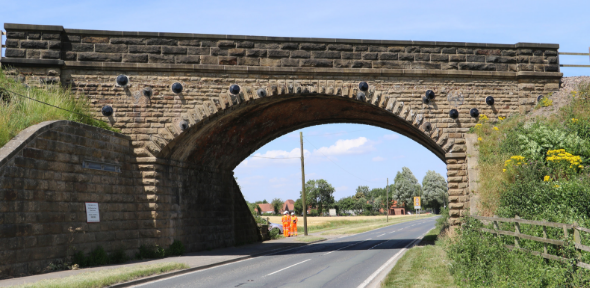
In 2018, Network Rail commissioned CSIC and AECOM to install structural health monitoring technologies on a skewed masonry arch bridge in North Yorkshire, which had suffered extensive historic damage. The technologies would monitor how the 150-year-old bridge behaved structurally and how it was responding to intervention work carried out in 2016. Network Rail also wanted to explore available monitoring technologies to determine which ones worked well and could be used on other assets. The system traditionally used in the UK is deflection pole monitoring, which measures vertical crown displacements at the arch soffit under the centre of the tracks above. However, this method often entails difficulties with access and may require costly and disruptive road closures.
Bespoke monitoring system
Following several desk studies, laser vibrometry and laser scanning at an initial monitoring visit, engineers were able to study the environment of the bridge and design a bespoke monitoring system. The vibrometry was used to provide an initial gauge of the magnitude of movements that the bridge was experiencing under typical train loading. The laser scan data was used to profile the surface of the bridge and to decide the locations of monitoring equipment, given the constraints of an A-road and footpath running underneath it.
CSIC installed distributed monitoring technologies, including a network of fibre optic Fibre Bragg Gratings for detailed dynamic measurement of strains across the arch, a laser scan analysis of historic deformations, and videogrammetry to capture dynamic displacements. AECOM installed an autonomous remote monitoring system comprising a range of dynamic, point-sensing technologies. Real-time monitoring with this system allows for accurate tracking of long-term trends in the monitoring data.
The bridge was monitored for six months from September 2018 to February 2019. Both teams from AECOM and CSIC analysed large quantities of data to co-author a series of reports for Network Rail. The reports summarised the studies undertaken before installation, the reasons the system was chosen, the evaluation of the technologies used, and the results to date. An upcoming report will also provide guidance on monitoring technologies that can be used as alternatives to the deflection pole method.
Next steps
Following internal review by the client, it is intended that these reports will be submitted to the European Shift2Rail programme as examples of research that Network Rail is supporting. Network Rail is also commissioning AECOM and CSIC to perform long-term monitoring of the bridge, which demonstrates the value of the installed monitoring system and the benefits of long-term structural health monitoring. As part of this, the CSIC FBG system will be upgraded to be autonomous and self-sufficient, running on solar power in the same way as AECOM’s remote point-sensing system. This enables FBG measurements to be taken automatically and monitoring data transferred back to the CSIC office for analysis. The teams from AECOM and CSIC have also been invited to present the project results to other asset engineers at Network Rail as an example of best practice.
This project has enabled CSIC to continue the development of fibre optic monitoring of heritage structures and carry out research into the fundamental behaviour of an existing skewed masonry arch railway bridge. Following refinement of the monitoring system at this bridge, it is expected that more testing on other bridges will take place in the next year.
Contact: Dr Matthew DeJong, University of California, Berkeley
Team: CSIC: Sam Cocking, Dr Haris Alexakis, Jason Shardelow. Network Rail: Sam De'Ath. AECOM: David Kite and Daniel Thompson
